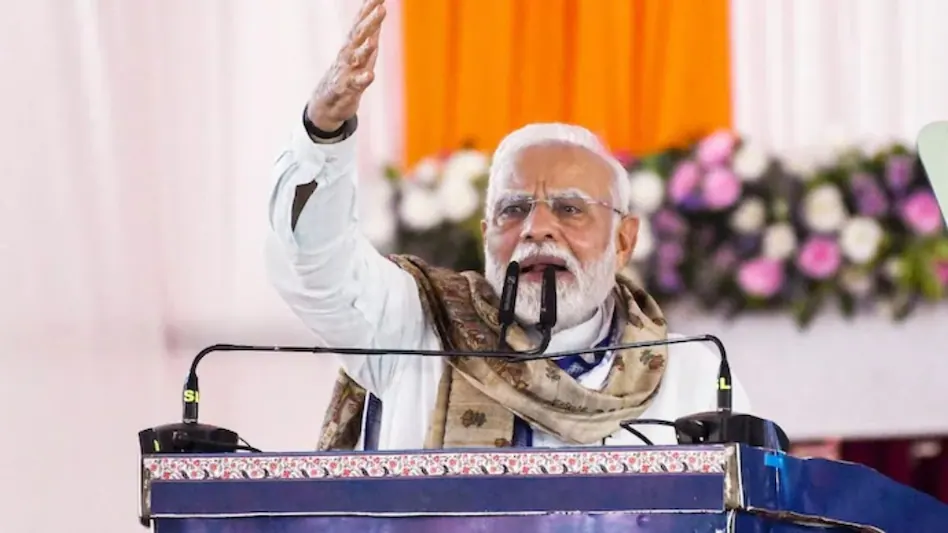
Today, the entire world is discussing the resolve for a developed India
PM Modi’s ₹5400 Crore Push – In a politically charged and economically ambitious visit to West Bengal’s industrial heartland, Prime Minister Narendra Modi unveiled a sweeping ₹5,400 crore development package aimed at transforming Durgapur and its surrounding districts into a hub of clean energy, modern infrastructure, and industrial revival. The announcement, made on July 18, 2025, is being seen as both a strategic investment in Bengal’s future and a bold political statement ahead of the state’s upcoming assembly elections.
Table of Contents
Infrastructure as the Engine of Growth
At the core of Modi’s Bengal blueprint is a belief that infrastructure is destiny. Addressing a packed gathering in Durgapur, the Prime Minister declared that India’s transformation into a developed nation by 2047 hinges on the scale and speed of its infrastructure expansion. “Today, the entire world is discussing the resolve for a developed India,” he said, “and Bengal must be a strong engine of that journey”.
The projects span multiple sectors oil and gas, power, rail, and road and are designed to boost connectivity, reduce pollution, and generate employment across the region.
Gas Grid Expansion: Fuelling Homes and Industries
One of the marquee announcements was the City Gas Distribution – CGD project by Bharat Petroleum Corporation Ltd (BPCL), worth ₹1,950 crore. Covering Bankura and Purulia districts, the initiative will deliver piped natural gas – PNG to households and industries, and compressed natural gas – CNG to retail outlets.
Complementing this is the 132-km Durgapur-Kolkata section of the Durgapur-Haldia Natural Gas Pipeline, built under the Pradhan Mantri Urja Ganga (PMUG) initiative at a cost of ₹1,190 crore. This pipeline traverses Purba Bardhaman, Hooghly, and Nadia, and is expected to benefit 25-30 lakh households, making clean energy more accessible and affordable.
Clean Energy Commitment: Pollution Control Upgrades
In line with India’s climate goals, Modi also inaugurated Flue Gas Desulphurisation (FGD) systems at the Durgapur Steel Thermal Power Station and Raghunathpur Thermal Power Station, operated by the Damodar Valley Corporation (DVC). These retrofitted systems, built at a combined cost of ₹1,457 crore, aim to curb sulphur dioxide emissions, improve air quality, and support cleaner industrial operations.
Rail and Road Connectivity: Linking Industry to Opportunity
To ease freight movement and improve regional logistics, the Prime Minister inaugurated the doubling of the 36-km Purulia–Kotshila rail line, completed at a cost of ₹390 crore. This upgrade will facilitate smoother transport between industrial hubs like Jamshedpur, Bokaro, and Dhanbad, and urban centers such as Ranchi and Kolkata.
Additionally, two road overbridges (ROBs) constructed under the Setu Bharatam Programme at Topsi and Pandabeshwarw ere inaugurated, with a combined investment of ₹380 crore. These bridges are expected to reduce accidents and improve traffic flow across railway crossings.
Political Undertones: A Rallying Cry for Change
While the developmental announcements were the centerpiece, Modi’s visit also carried strong political undertones. In a fiery speech, he accused the Trinamool Congress (TMC) government of stalling Bengal’s progress through “corruption, lawlessness, and hostility to investment.” He lamented the decline of industrial cities like Durgapur and Asansol, once icons of India’s manufacturing prowess.
“The TMC government has become a wall standing against Bengal’s development,” Modi declared. “The day it collapses, Bengal will catch the speed of development”.
Reviving Industrial Legacy: Steel and Power Modernization
Modi invoked the legacies of Dr. Shyama Prasad Mukherjee and Dr. Bidhan Chandra Roy, highlighting Bengal’s historical contribution to India’s economic and intellectual growth. He announced that major steel and power plants in Durgapur and Raghunathpur have been modernized with cutting-edge technology, backed by an investment of ₹1,500 crore.
These upgrades aim to make the plants more efficient, globally competitive, and capable of generating local employment a key promise to Bengal’s youth, many of whom have migrated in search of jobs.
Digital and Social Infrastructure: The Broader Vision
Beyond physical infrastructure, Modi emphasized the importance of digital and social infrastructure. He cited achievements like 4 crore pucca houses, 12 crore tap water connections, and widespread internet access as part of the broader transformation underway across India.
He also highlighted Bengal’s growing rail connectivity, noting the expansion of the Kolkata Metro, the operation of multiple Vande Bharat trains, and the modernization of railway stations. The Kazi Nazrul Islam Airport, integrated under the UDAN scheme, has already served over 5 lakh passengers in the past year.
Vision for Viksit Bharat: Empowerment Through Development
Modi reiterated his government’s roadmap for a Viksit Bharat by 2047, built on three pillars:
- Empowerment through development
- Self-reliance through employment
- Good governance through responsiveness
He assured the people of Bengal that these values would guide future investments and policy decisions, and that the state would be made a “strong engine of India’s development journey”.
Final Thoughts on PM Modi’s ₹5400 Crore Push : A Promise or a Pitch?
PM Modi’s ₹5,400 crore development push in Bengal is both a promise of progress and a political pitch. It seeks to reignite the state’s industrial legacy, address long-standing infrastructure gaps, and position Bengal as a key player in India’s growth story.
Whether this blueprint translates into tangible change or remains a campaign narrative will depend on execution, collaboration, and the will of the people. But for now, Durgapur stands as a symbol of what’s possible when ambition meets investment and when politics aligns with progress.
Stay updated with the latest news on Rapido Updates. Keep yourself updated with The World, India News, Entertainment, Market, Automobile, Gadgets, Sports, and many more